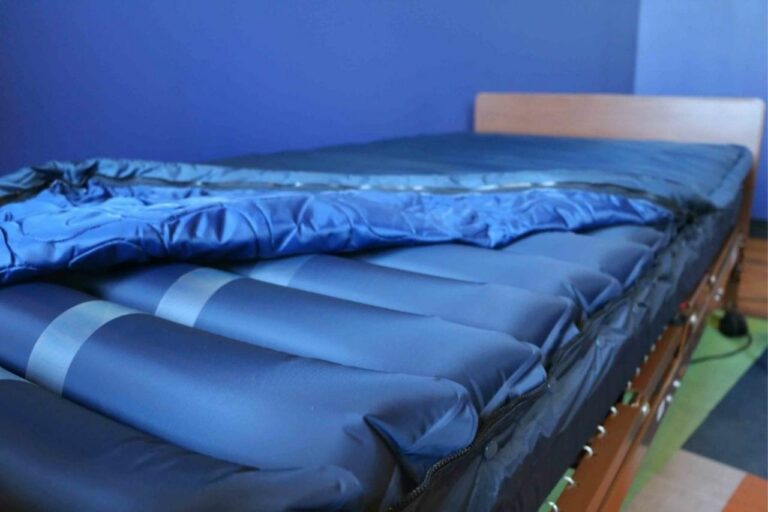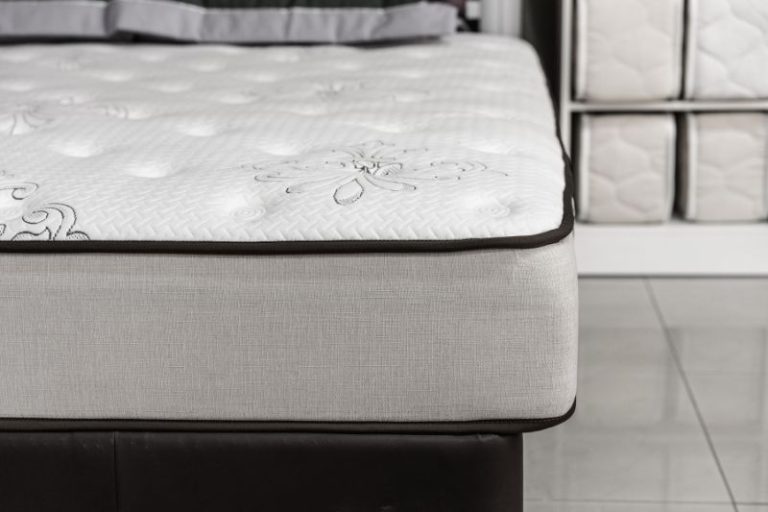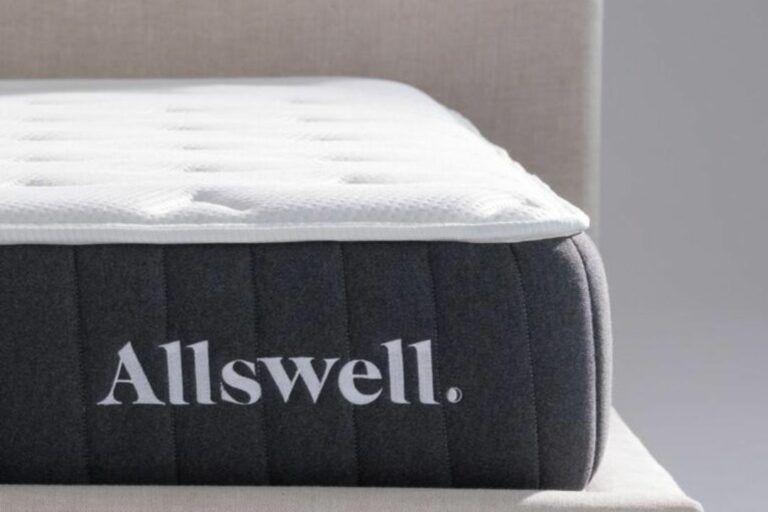Can You Be Allergic to a Tempurpedic Mattress? (ANSWERED!)

Tempur-Pedic mattresses are known for their comfort and ability to provide a good night’s sleep. However, some people may wonder,
Can You Be Allergic to a Tempurpedic Mattress?
Allergies can be caused by a variety of factors, including materials used in the manufacturing of products. In the case of Tempur-Pedic mattresses, the foam used to make the mattress may contain chemicals that can trigger an allergic reaction in some people.
Additionally, some people may be allergic to the dust mites that can accumulate in the mattress over time.
If you are experiencing symptoms such as sneezing, watery eyes, or a runny nose after sleeping on a Tempur-Pedic mattress, it’s important to consult with your doctor to determine if you have an allergy.
In some cases, switching to a different type of mattress or using allergy-proof covers may be recommended to alleviate symptoms.
What is a Tempurpedic Mattress?
A Tempurpedic mattress is a type of memory foam mattress that was first developed by NASA in the 1970s.
The idea behind the technology was to create a material that could conform to the shape of an astronaut’s body to help relieve pressure points during liftoff.
Tempurpedic mattresses are made with a proprietary type of memory foam that is designed to respond to the heat and pressure of a person’s body.
The foam is also designed to distribute weight evenly across the surface of the mattress, which can help to reduce pressure points and improve circulation.
One of the benefits of a Tempurpedic mattress is that it can help to reduce motion transfer between partners.
This means that if one person moves around during the night, the other person is less likely to be disturbed.
Tempurpedic mattresses are also known for their durability.
They are designed to last for many years without losing their shape or support.
Overall, Tempurpedic mattresses are a popular choice for people who are looking for a high-quality, supportive mattress that can help to relieve pressure points and improve sleep quality.
Allergic Reactions to Tempurpedic Mattresses:
Tempurpedic mattresses are popular for their comfort and support.
However, some people may experience allergic reactions to these mattresses.
The most common allergic reaction to Tempurpedic mattresses is contact dermatitis.
This occurs when the skin comes into contact with certain chemicals used in the manufacturing process of the mattress.
Symptoms of contact dermatitis may include redness, itching, and swelling of the affected area.
Another possible allergic reaction is respiratory irritation.
This may occur due to the release of volatile organic compounds (VOCs) from the mattress.
VOCs are chemicals that can cause eye, nose, and throat irritation, headaches, and dizziness.
It is important to note that not everyone will experience an allergic reaction to a Tempurpedic mattress.
Those who are sensitive to chemicals or have pre-existing respiratory conditions may be more likely to experience symptoms.
To reduce the risk of allergic reactions, individuals can consider purchasing a hypoallergenic mattress cover or choosing a mattress made from natural materials.
It is also recommended to air out the mattress for a few days before use to allow any VOCs to dissipate.
Overall, while allergic reactions to Tempurpedic mattresses are possible, they are not common.
It is important to be aware of the potential risks and take necessary precautions to minimize them.
What are the symptoms of mattress allergy?
Here are some common symptoms of a mattress allergy:
- Sneezing
- Runny or stuffy nose
- Itchy or watery eyes
- Skin rash or hives
- Difficulty breathing or shortness of breath
- Coughing or wheezing
- Headache or sinus pressure
- Fatigue or drowsiness
- Nausea or vomiting (less common)
- Anaphylaxis (a severe allergic reaction that can cause swelling, difficulty breathing, and a drop in blood pressure) – extremely rare.
It’s important to note that some of these symptoms may also be caused by other factors, such as dust mites or mold in the mattress. If you suspect you have a mattress allergy, it’s best to consult with a healthcare professional for proper diagnosis and treatment.
Are Tempur-Pedic mattresses full of chemicals?
Tempur-Pedic mattresses are known for their unique memory foam technology, which is made from a material called viscoelastic polyurethane foam.
This material is created by combining polyurethane foam with various chemicals to give it its unique properties.
While it’s true that some of the chemicals used in the production of Tempur-Pedic mattresses can be potentially harmful, the company has taken steps to minimize their use and ensure that their products are safe for consumers.
For example, Tempur-Pedic mattresses are certified by CertiPUR-US, which means that they meet rigorous standards for content, emissions, and durability.
This certification ensures that the foam used in Tempur-Pedic mattresses is free from harmful chemicals such as formaldehyde, heavy metals, and phthalates.
Additionally, Tempur-Pedic has also received the Oeko-Tex Standard 100 certification, which means that their products have been tested for harmful substances and found to be safe for human use.
It’s worth noting that some people may still be sensitive to certain chemicals used in the production of Tempur-Pedic mattresses, such as the off-gassing of volatile organic compounds (VOCs) that can occur when the mattress is first unpacked.
However, this is true for many types of mattresses, and Tempur-Pedic has taken steps to minimize this issue by allowing their mattresses to air out before shipping them to customers.
Overall, while Tempur-Pedic mattresses do contain some chemicals, the company has taken steps to ensure that their products are safe for consumers and comply with industry standards for content and emissions.
Do Tempur-Pedic mattresses give off gases?
Yes, like many other types of mattresses, Tempur-Pedic mattresses can emit gases, particularly when they are first unpacked.
This process is known as off-gassing, and it occurs when volatile organic compounds (VOCs) are released from the foam used in the mattress.
VOCs are chemicals that can have a negative impact on indoor air quality and can potentially cause health issues such as headaches, dizziness, and respiratory problems.
However, it’s important to note that the levels of VOCs released by Tempur-Pedic mattresses are generally considered to be low and not harmful to most people.
Tempur-Pedic has taken steps to minimize off-gassing in their products.
They allow their mattresses to air out for a period of time before shipping them to customers, which can help to reduce the amount of VOCs emitted.
Additionally, the company uses foam that is certified by CertiPUR-US, which means that it meets rigorous standards for content, emissions, and durability.
This certification ensures that the foam used in Tempur-Pedic mattresses is free from harmful chemicals such as formaldehyde, heavy metals, and phthalates.
While some people may be sensitive to the off-gassing of VOCs, it’s worth noting that this issue is not unique to Tempur-Pedic mattresses and can occur with many types of foam-based products.
If you are concerned about off-gassing, it’s a good idea to allow your mattress to air out in a well-ventilated area for a few days before using it.
You can also look for mattresses that are certified by organizations such as CertiPUR-US or Oeko-Tex, which ensure that the products meet rigorous standards for safety and environmental impact.
Tempurpedic Mattress: (Pros And Cons)
Some of the pros and cons of Tempur-Pedic mattresses:
| Pros | Cons |
|---|---|
| Provides excellent pressure relief and support | Can be more expensive than other types of mattresses |
| Conforms to your body for personalized comfort | Can be heavy and difficult to move |
| Reduces motion transfer, making it ideal for couples | Can have a slight chemical odor when first unpacked |
| Durable and long-lasting | May feel too firm for some people |
| Available in a range of firmness levels and styles | May retain heat and feel warm to sleep on |
| Can help alleviate pain and discomfort | May take some time to get used to the feel of the foam |
It’s worth noting that the pros and cons of Tempur-Pedic mattresses can vary depending on the specific model and individual preferences.
Some people may find that the benefits of a Tempur-Pedic mattress outweigh the drawbacks, while others may prefer a different type of mattress altogether.
Ultimately, it’s important to carefully consider your needs and preferences when choosing a mattress to ensure that you find one that provides the comfort and support you need for a good night’s sleep.
Conclusion: Can You Be Allergic to a Tempurpedic Mattress?
While it’s possible to be allergic to any type of material, including the foam used in Tempur-Pedic mattresses, it’s relatively rare.
The foam used in Tempur-Pedic mattresses is certified by CertiPUR-US and Oeko-Tex Standard 100, which means that it meets rigorous standards for content, emissions, and durability, and is free from harmful chemicals such as formaldehyde, heavy metals, and phthalates.
However, some people may be sensitive to the off-gassing of volatile organic compounds (VOCs) that can occur when the mattress is first unpacked.
This can cause symptoms such as sneezing, runny nose, itchy eyes, and skin rash.
These symptoms are generally mild and temporary, and can be minimized by allowing the mattress to air out in a well-ventilated area before use.
If you have a history of allergies or sensitivity to certain materials, it’s always a good idea to consult with a healthcare professional before purchasing a new mattress.
They can help you determine if a Tempur-Pedic mattress is a good choice for you, and provide advice on how to minimize any potential allergic reactions or symptoms.






